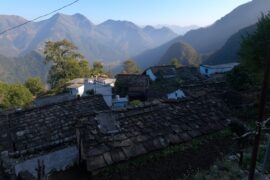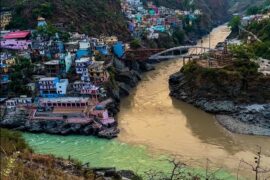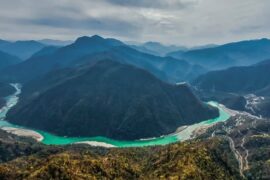Beyond Mahavatar Babaji’s Cave Photos: An Authentic Spiritual Guide
Every spiritual seeker who has read Paramahansa Yogananda’s Autobiography of a Yogi dreams of standing where the immortal guru Mahavatar Babaji initiated Lahiri Mahasaya into Kriya Yoga. This sacred spot is the famous Babaji Cave, nestled high in the Dunagiri mountains near Kukuchina, Uttarakhand.

mahavatar babaji’s cave photos
While searching for “Mahavatar Babaji’s Cave photos” offers a glimpse, the true visual and spiritual experience begins where the road ends. This guide takes you beyond the snapshot, detailing the three powerful phases of this Himalayan pilgrimage.
The Mahavatar Babaji Cave, located in the Pandukholi Mountain range near Kukuchina village in Uttarakhand, is less a tourist attraction and more a primal, sacred haven. Its visual presence is one of profound simplicity, untouched nature, and immense spiritual energy, attracting Kriya Yogis and seekers from around the globe.
Here is a detailed look at what to expect on your pilgrimage, from the surrounding mountain trail to the innermost sanctum.

1. Phase One: The Ascent Through the Himalayan Pine Forest
The physical journey to the cave begins at Kukuchina, marking the start of a challenging yet beautiful 3-kilometer trek. This phase is less about hiking and more about acclimatizing your mind to the spiritual energy of the Himalayas.

The Visuals of the Trek
- A Forest of Giants: The path immediately winds steeply uphill through dense stands of towering pine and oak trees. The forest is thick, creating a secluded atmosphere where the only sounds are the rustle of wind and the crunch of pine needles underfoot.
- The Challenging Climb: Pilgrims must prepare for a true mountain ascent. The trail is rough—a mix of natural dirt, small rocks, and sometimes uneven stone steps. The challenging steepness (up to 40 degrees in sections) serves as an immediate, physical meditation, demanding full presence.
- Nature’s Rewards: Look for the vibrant contrast provided by the surrounding flora. During spring, the path comes alive with scattered red and pink rhododendron blooms, setting a spectacular backdrop against the stark mountain face.
- Panoramic Vistas: As you climb, the forest occasionally yields to spectacular natural clearings, offering expansive panoramic views of the sprawling Kumaon valleys and the distant, majestic Himalayan peaks. These rest stops are powerful moments for contemplation.
Suggested Read: Rishikesh to Babaji Cave: Discover distance, key stops and travel time

2. Phase Two: The Sanctuary Before the Sanctum
Roughly an hour into the trek, the energy shifts as you approach the ancillary structures maintained by the Yogoda Satsanga Society of India (YSS).
The Meditation Hut
- Just before the final section of the climb, you may encounter a small, simple YSS Meditation Hut. This humble structure provides a quiet space adorned with photographs of the Kriya Yoga masters.
- Many pilgrims choose to pause here for a formal meditation session, utilizing the concentrated energy of the mountain to prepare their hearts and minds for the cave itself.

The Entrance Portal
A few minutes later, the cave exterior comes into view. Visually, it is deliberately understated.
- Humble and Hidden: It is not a grand cavern, but an unassuming, dark opening tucked into the rocky mountainside. This simplicity is intentional, reinforcing that the spiritual experience is entirely internal.
- The Gate of Humility: The small, low-cut entrance is protected by a simple iron gate or barrier for conservation. To enter the main chamber, pilgrims must often crouch or even crawl slightly—a potent physical gesture symbolizing the necessary humility required before entering such a sacred space.
- The Sacred Tree: Look for the powerful, ancient tree nearby—often mentioned in devotee accounts as a spot charged with the energy of the divine masters.

3. Phase Three: Inside the Birthplace of Kriya Yoga
The final visual and spiritual climax is the cave interior.
Inside the Cave
- The Chamber of Silence: The interior is surprisingly small, a sanctuary of profound simplicity, typically only large enough to accommodate 5 to 10 people sitting cross-legged.
- Pristine Setup: The natural earthen floor is leveled and covered with meditation mats or fabric for comfort. The temperature remains consistently cool, regardless of the weather outside.
- The Simple Altar: The focal point is a simple stone platform or shelf acting as an altar, meticulously maintained with fresh flowers, burning incense, and revered photographs of the Kriya Yoga lineage.
- The Palpable Energy: This small chamber vibrates with an intense, quiet energy. Visitors unanimously report a powerful, almost palpable sense of peace and stillness. The cave’s small physical dimension paradoxically amplifies the concentrated energy, making it an ideal environment for deep introspection and Kriya Yoga practice.

The journey to Babaji’s Cave is a profound blend of Himalayan trekking and deep spiritual immersion. It is an experience captured not fully by photos, but by the profound stillness felt at the birthplace of Kriya Yoga.
Planning Your Visit: The cave is located near Dwarahat in the Almora district. The best time to visit for clear views and trekking conditions is April–June and September–November. Want to Plan Your Trip? Learn about the nearest railway station in our other guide!
mahavatar babaji’s cave photos mahavatar babaji’s cave photos mahavatar babaji’s cave photos mahavatar babaji’s cave photos



Comments are closed.